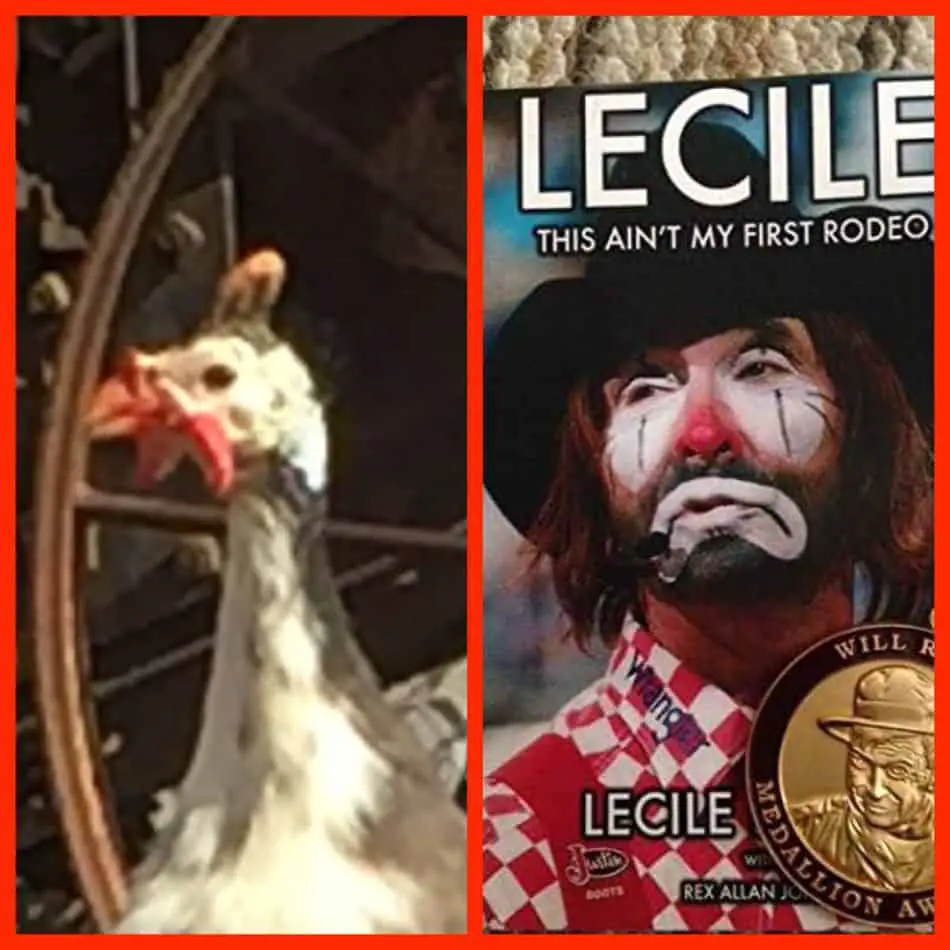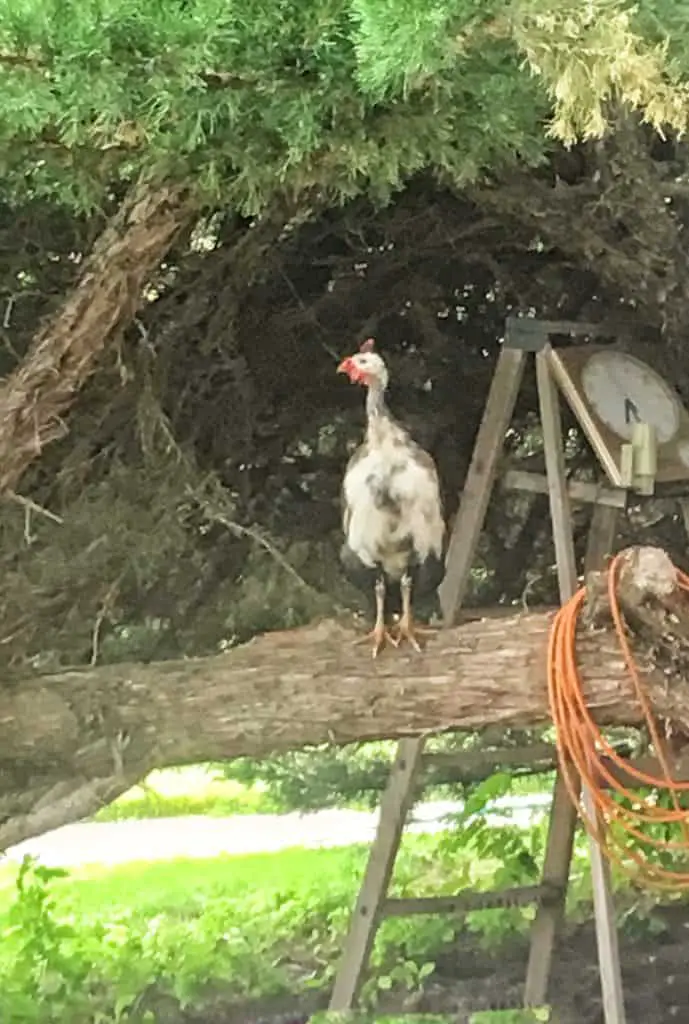I’d like to introduce you to Lecile, that’s right, Lecile, named after the Pro Rodeo Hall of Fame and hometown rodeo favorite Lecile Harris who you can read about here.
Which backyard animal deserves to be named after such a unique looking and comedic genius, you ask? Well, that would be our adopted, strange looking, rather loud and comedic feathered friend the guinea hen. Just over two years ago, a guinea hen was left on our chicken coop doorstep by a neighbor who must have thought there was no real difference between backyard fowl of varying species. We decided we would attempt to integrate her with our chicken flock and see how things went.

I tell you, the differences became readily apparent, and quickly! In no time at all, Lecile was running the roost, and had appointed herself the head of the pecking order, in spite of her clown like appearance and rather awkward cries. Though it took a few weeks, the chickens came to accept Lecile’s role in the flock, and have allowed her her place in the roost quite naturally.
We have learned a lot about guinea fowl since adopting Lecile, and have come to appreciate her unique policing, quirky habits, voracious appetite, and her intensely protective characteristics. It turns out that her modus operandi is rather typical of all guinea fowl, and that adding one or more guineas to your backyard chicken flock can be quite helpful; although, we would recommend a few caveats.
Basic Characteristics of Guinea Fowl
Like turkeys, guinea fowl are Galliformes, a group encompassing all heavy bodied ground-feeding (and chicken-like) birds, but from a different family than the chicken. The Guinea fowl belong to the Numida family. They originate from Africa, where they free range in large flocks, hunting as a team, and were brought to Europe in the 15th century by Portuguese explorers. They were later integrated into North American poultry habitats by the early American settlers.
There are seven species of guinea fowl, however the helmeted pearl is the most common, and almost exclusive species found in North America. The helmeted pearl is identified by an odd vulturine or clownlike appearance that includes a spear shaped “helmet”or knob on the skull, a white (often bluish in hue) featherless face, grey polka-dotted feathers, and bright red wattles. The guinea hen is about the size of a large chicken, and when fully grown, may weigh more than 4 lbs.
Guinea fowl do not reach sexual maturity until almost two years of age, thus making it difficult to distinguish sex when raising them. Sex is important however, as male guinea fowl are known to be extremely territorial and when mixed with chickens or other fowl, will fight with, or run off the roosters. Though bossiness is typical of guineas in general, males are particularly dominant, and can become quite brutal when it comes to establishing their place at the top of the pecking order.
Behavior and Temperament of Guinea Fowl:
As stated above, guinea fowl are bossy, when compared to the docile and domesticated nature of most backyard chicken breeds. Because of this, they will likely dominate the flock. This isn’t typically a problem, and most chicken breeds do not have any qualms with allowing the guinea hen a place of dominance.

Remember that the guinea fowl is not a fully domesticated bird, and will need a little extra space in the coop, or choose to roost separate from the flock, in a tree or other high place come dusk. Some folks are able to coax their guineas into the coop at night with fresh water and regular feed. It is suggested that keeping a low watt bulb in the coop for the first few weeks of confinement may also help the guinea fowl to settle in and become familiar with the coop.
Guinea fowl are fantastic foragers and relentless hunters. Given free range, the guinea fowl will spend the entire day hunting your property for bugs, including potato beetles, ticks, mites, locusts, spiders, termites, cutworms, grubs, snails, ants and any other garden or yard bugs they can locate. In some farming or orchard areas, guinea fowl are used to scare off marauding wild birds, snakes, and other predators. When several guineas are present, they will hunt as a team, marching together and devouring anything they startle. When they encounter a larger target such as a mouse or snake, they will encircle it, and take turns to peck and scratch to move in and kill/devour the feast together.
An additional unique characteristic of the guinea fowl is their policing ability. Often a first defense against predators from the ground or air, the guinea fowl, both male and female, have a distinguishing cry of warning. Though this loud cry of alarm has been helpful in protecting our chicken flock from hawks and other predators, it has also been a source of much laughter, as visiting friends who don’t know we are raising a guinea will hear Lecile’s loud call from the backyard and wonder if we are raising a pack of wild monkeys or other rain forest creatures.
The call of a guinea hen is unique. If you’ve got an extra 5 minutes and are curious about the different calls made by both female and male guineas, check out these youtube videos from Guinea Fowl TV here, (for males), and here (for females). Because of the loud nature of guinea fowl, you will certainly want to consider the proximity of neighbors if you are thinking of adding one or more to your backyard flock, or raising your own flock of guineas. They certainly can’t be kept mum the way chicken hens can. Imagine trying to keep a rooster quiet in a close quartered urban neighborhood. Impossible.
Egg Laying and Mating Characteristics
Guinea fowl aren’t necessarily known for their egg production abilities. The typical guinea hen will lay eggs seasonally, between March/April through September/October depending on where you live, beginning when she is 26-28 weeks old. The average hen will lay about 100 eggs per laying season.
Guinea hen eggs are smaller than chicken eggs, and are typically a light pink or brown color, sometimes with speckles. The shell itself is much harder than a typical chicken egg shell. Our guinea, Lecile’s eggs are a bit longer and more tapered than chicken eggs, and appear to have a shinier surface. She also likes to find odd places to lay her eggs. Though we have found her eggs in the regular nesting boxes with the chicken eggs, we have also found them on the floor in the coop, and in the long grass under our antique horse-drawn seeder and hay rake, in the yard. She seems to enjoy making us hunt for her eggs.
If you are raising a group of guineas, they have been known to engage in the practice of “communal laying”, where all hens will lay their eggs in a communal nest until there are upwards of 30-40 eggs. Additionally, the hens may act as communal brooders, taking turns to sit on the large collection of eggs until hatching.
As far as mating and family relationships go, people are often surprised to learn that guinea fowl cocks form a strong attachment with their hens. When a hen becomes broody and decides to sit on a nest of eggs you will almost always find her mate, the cock, guarding nearby. He will create quite the clatter if he sees what he perceives to be a threat approaching. In the wild, guinea hens are monogamous and mate for life, however, in a small farm setting, the typical mating ratio will rise to 1:5. Contrary to rooster behavior, a philandering guinea hen is the exception, and not the norm.
So there you have it. Some of the pro’s and con’s of raising a guinea hen or two with your backyard chicken flock. Having experienced this on our farm firsthand, we have definitely become fans of this breed. Lecile is a unique and quirky addition to our yard, and though bossy and even unruly at times, she does a great job of clearing the yard and garden of pesky insects, as well as providing a protective alarm and safeguard from would be predators.
So, all in all, I guess the name fits. Not only does Lecile’s appearance remind us of the great rodeo clown, Lecile Harris, but her imperious antics, like the clown’s witty banter, have brought us to tears of laughter on many occasions.

